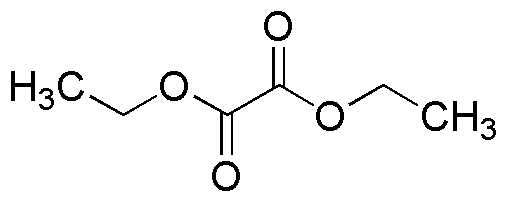Ethyl oxalate is widely utilized in research focused on:
- Synthesis of Pharmaceuticals: It serves as an important intermediate in the production of various pharmaceutical compounds, enhancing the efficiency of drug development processes.
- Flavoring and Fragrance Industry: Ethyl oxalate is used as a flavoring agent in food products and as a fragrance component in cosmetics, providing a pleasant aroma and taste.
- Solvent Applications: This compound acts as a solvent in chemical reactions and extractions, facilitating the dissolution of various organic compounds and improving reaction yields.
- Polymer Production: It is employed in the synthesis of polymers, particularly in the creation of polyesters, which are widely used in textiles and packaging materials.
- Analytical Chemistry: Ethyl oxalate is utilized as a reagent in analytical methods, aiding in the detection and quantification of metal ions, which is crucial in environmental monitoring and quality control.
General Information
Properties
Safety and Regulations
Applications
Ethyl oxalate is widely utilized in research focused on:
- Synthesis of Pharmaceuticals: It serves as an important intermediate in the production of various pharmaceutical compounds, enhancing the efficiency of drug development processes.
- Flavoring and Fragrance Industry: Ethyl oxalate is used as a flavoring agent in food products and as a fragrance component in cosmetics, providing a pleasant aroma and taste.
- Solvent Applications: This compound acts as a solvent in chemical reactions and extractions, facilitating the dissolution of various organic compounds and improving reaction yields.
- Polymer Production: It is employed in the synthesis of polymers, particularly in the creation of polyesters, which are widely used in textiles and packaging materials.
- Analytical Chemistry: Ethyl oxalate is utilized as a reagent in analytical methods, aiding in the detection and quantification of metal ions, which is crucial in environmental monitoring and quality control.
Documents
Safety Data Sheets (SDS)
The SDS provides comprehensive safety information on handling, storage, and disposal of the product.
Product Specification (PS)
The PS provides a comprehensive breakdown of the product’s properties, including chemical composition, physical state, purity, and storage requirements. It also details acceptable quality ranges and the product's intended applications.
Certificates of Analysis (COA)
Search for Certificates of Analysis (COA) by entering the products Lot Number. Lot and Batch Numbers can be found on a product’s label following the words ‘Lot’ or ‘Batch’.
Número de catálogo
Número de lote/lote
Certificates Of Origin (COO)
This COO confirms the country where the product was manufactured, and also details the materials and components used in it and whether it is derived from natural, synthetic, or other specific sources. This certificate may be required for customs, trade, and regulatory compliance.
Número de catálogo
Número de lote/lote
Safety Data Sheets (SDS)
The SDS provides comprehensive safety information on handling, storage, and disposal of the product.
DownloadProduct Specification (PS)
The PS provides a comprehensive breakdown of the product’s properties, including chemical composition, physical state, purity, and storage requirements. It also details acceptable quality ranges and the product's intended applications.
DownloadCertificates of Analysis (COA)
Search for Certificates of Analysis (COA) by entering the products Lot Number. Lot and Batch Numbers can be found on a product’s label following the words ‘Lot’ or ‘Batch’.
Número de catálogo
Número de lote/lote
Certificates Of Origin (COO)
This COO confirms the country where the product was manufactured, and also details the materials and components used in it and whether it is derived from natural, synthetic, or other specific sources. This certificate may be required for customs, trade, and regulatory compliance.

